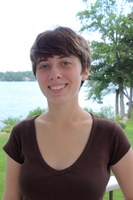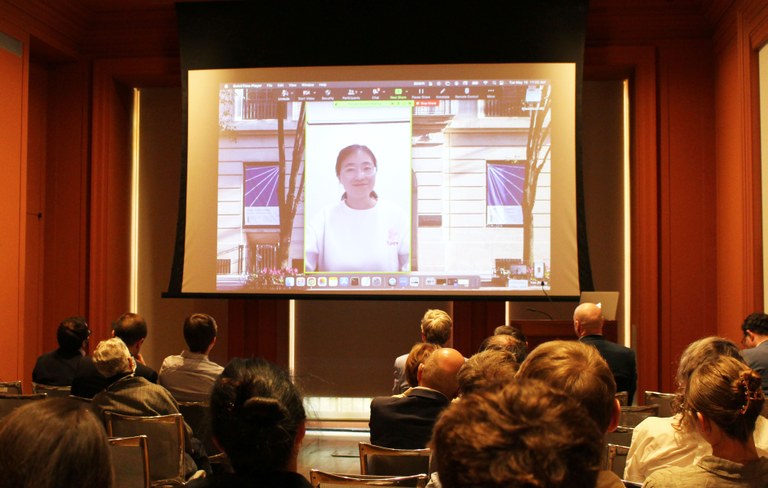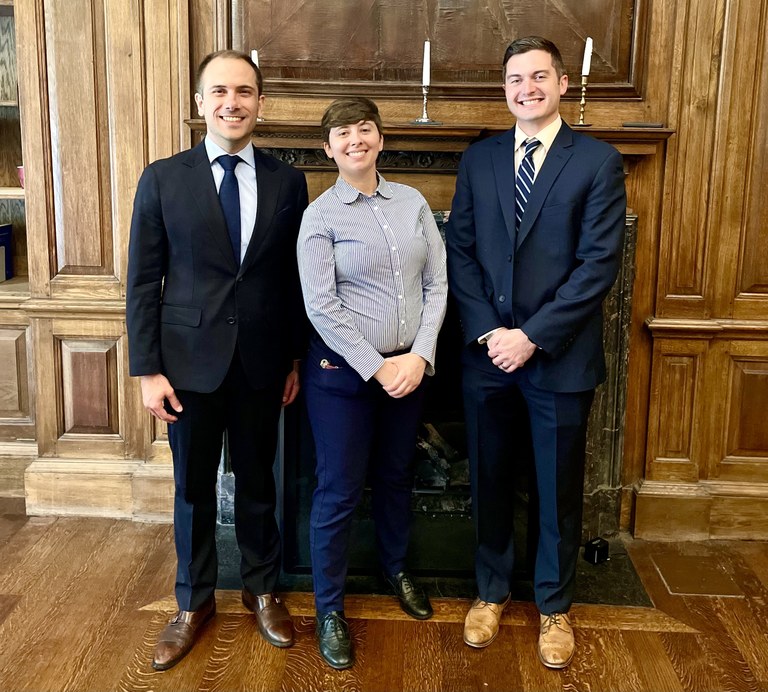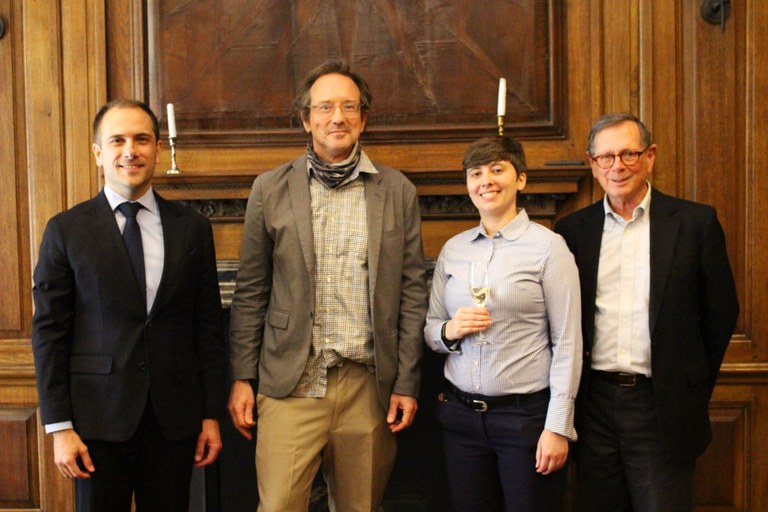ISAW Commencement 2023
Four ISAW students were awarded doctoral degrees during the 2022-23 academic year: Georgios Tsolakis (September 2022), Yan Zhang (September 2022), Christine Roughan (January 2023), and Nathan Lovejoy (May 2023). The ISAW community celebrated these students' accomplishments at an in-person graduation ceremony and reception on May 16, 2023. We are extremely proud of ISAW’s recent graduates!
Our PhD Graduates
 Georgios Tsolakis received a BA in History and Archaeology and an MA in Greek and Roman History from the Aristotle University of Thessaloniki. He has received several prestigious fellowships and grants, including an Alexander S. Onassis Public Benefit Foundation Scholarship (2017-20), a Stavros Niarchos Foundation Scholarship (2017), an American Society of Papyrologists Fellowship (2018), and an NYU Digital Humanities Graduate Student Summer Fellowship (2021). Georgios is a participant in the Lyktos Archaeological Project (Greece) and is working on an edition of several epigraphic texts that illustrate the political, social, and economic life of the Cretan city of Lyktos. He is the co-author (with Elias Sverkos) of the Supplementum Epigraphicum Graecum: Consolidated Concordances for Volumes XLVI – LX (1996 – 2010) (Leiden/Boston: Brill, 2021), a guide to the inscriptions published, mentioned, or discussed in the respective volumes of SEG. Since September 2022, he has been the project manager of Roman Statutes: Renewing Roman Law, a collaborative project on all epigraphically-preserved Roman laws under the direction of Clifford Ando. He is currently a Postdoctoral Researcher and Instructor in the Department of Classics at the University of Chicago.
Georgios Tsolakis received a BA in History and Archaeology and an MA in Greek and Roman History from the Aristotle University of Thessaloniki. He has received several prestigious fellowships and grants, including an Alexander S. Onassis Public Benefit Foundation Scholarship (2017-20), a Stavros Niarchos Foundation Scholarship (2017), an American Society of Papyrologists Fellowship (2018), and an NYU Digital Humanities Graduate Student Summer Fellowship (2021). Georgios is a participant in the Lyktos Archaeological Project (Greece) and is working on an edition of several epigraphic texts that illustrate the political, social, and economic life of the Cretan city of Lyktos. He is the co-author (with Elias Sverkos) of the Supplementum Epigraphicum Graecum: Consolidated Concordances for Volumes XLVI – LX (1996 – 2010) (Leiden/Boston: Brill, 2021), a guide to the inscriptions published, mentioned, or discussed in the respective volumes of SEG. Since September 2022, he has been the project manager of Roman Statutes: Renewing Roman Law, a collaborative project on all epigraphically-preserved Roman laws under the direction of Clifford Ando. He is currently a Postdoctoral Researcher and Instructor in the Department of Classics at the University of Chicago.
Georgios's doctoral dissertation, which he defended on August 4, 2022, is entitled "Ancestors and Family Traditions in Hellenistic and Imperial Polis." According to his advisor, Roger Bagnall: "(Georgios's) success rests on a combination of traits that make for the foundation of a successful academic—and not only academic—life. Georgios shows up. He's punctual. He works very hard and systematically. He is highly productive. He learns quickly and readily. And he communicates the results of his work clearly and efficiently to extremely varied audiences. He also works collaboratively with others very well—something we try to foster here—and has consistently been a really positive influence in any group that he's been a part of. He's been extremely active in seeking opportunities to present research at international conferences, representing ISAW in these fora, and these presentations have been consistently well received—giving him an excellent European network of scholarly peers and mentors. And he is an indefatigable traveler to sites and museums around the ancient world. Perhaps we should be able to take all of this for granted, but I'm afraid I don't and I can't. But, of course, perhaps more important than any of this for survival are two crucial qualities—he has a great sense of humor, and he makes a fabulous spanakopita. He'll go far."
 Yan Zhang received a BA and MA in Archaeology from Peking University. Her areas of research interest include zooarchaeology, Chinese archaeology, Bronze Age archaeology, and later Prehistoric/Bronze Age China. Yan has done fieldwork and lab work on animal remains from various sites in China, including Guandimiao, Xiaomintun, Zhougongmiao, Qingshui, Buyao, Hake, and Donghulin. She has also done research on animal remains from the World Trade Center site in New York City. Yan has taught as an adjunct instructor in the College Core Curriculum at NYU and as a lecturer at Henan University. In addition, Yan has co-authored the following publications: Yanfeng Hou, Roderick Campbell, Yan Zhang, and Suting Li, "Animal use in a Shang Village: The Guandimiao zooarchaeological assemblage," International Journal of Osteoarchaeology 29:2 (2019): 335-345; Yanfeng Hou, Roderick Campbell, Zhipeng Li, Yan Zhang, Suting Li, and Yuling He, "The Guandimiao Bone Assemblage (and What it Says about the Shang Economy)," Asian Perspectives 57:2 (2018): 281-310.
Yan Zhang received a BA and MA in Archaeology from Peking University. Her areas of research interest include zooarchaeology, Chinese archaeology, Bronze Age archaeology, and later Prehistoric/Bronze Age China. Yan has done fieldwork and lab work on animal remains from various sites in China, including Guandimiao, Xiaomintun, Zhougongmiao, Qingshui, Buyao, Hake, and Donghulin. She has also done research on animal remains from the World Trade Center site in New York City. Yan has taught as an adjunct instructor in the College Core Curriculum at NYU and as a lecturer at Henan University. In addition, Yan has co-authored the following publications: Yanfeng Hou, Roderick Campbell, Yan Zhang, and Suting Li, "Animal use in a Shang Village: The Guandimiao zooarchaeological assemblage," International Journal of Osteoarchaeology 29:2 (2019): 335-345; Yanfeng Hou, Roderick Campbell, Zhipeng Li, Yan Zhang, Suting Li, and Yuling He, "The Guandimiao Bone Assemblage (and What it Says about the Shang Economy)," Asian Perspectives 57:2 (2018): 281-310.
Yan's doctoral dissertation, which she defended on August 16, 2022, is entitled "Feeding Status: A Comparative Study of Animal Foodways and Social Status in the Chinese Bronze Age (Anyang, Guandimiao, and Zhougongmiao, 13th-8th century BCE)." According to her advisor, Roderick Campbell: "Yan studied the relationship between food and status in the Chinese Bronze Age, which is a huge topic and a really important one. She did it by combining the study of Zhougongmiao, a very important Predynastic and Dynastic Zhou site to the west of the Shang, with the study of Xiaomintun, the Shang capital site and non-elite locus at Anyang, and a Shang village site at Guandimiao. Not only did she do most of the basic analysis of the Zhougongmiao and Guandimiao assemblages, she added studies of butchery patterns, measured pot sizes, compared them to bone fragments, conducted experiments replicating possible tools and butchery methods, and combined all of these analyses with stable isotopes into a comprehensive study of animal food practices, from husbandry to butchery and cooking, something that had never been done before in China, as well as bringing together three of the most important sites of the Chinese Bronze Age in comparison. So if that sounds like a lot, it was. And in the end she wrote, in my opinion, the best Chinese zooarchaeological dissertation ever completed."
 Christine Roughan received a BA in Classics at the College of the Holy Cross. She is an Adjunct Professor for NYU's Program in Digital Humanities and Social Science and a Technical Manager for Brown University's Inscriptions of Israel/Palestine project. Her research interests include the history of science, manuscript studies, digital humanities, and the transmissions of knowledge around the ancient and medieval Mediterranean. Christine has received several prestigious fellowships and grants, including a Fulbright Student Award to Germany (2014-15), an NYU Antonina S. Ranieri International Scholars Fund Award (2020), and an NYU-GSAS Dean's Dissertation Fellowship (2021). Her publications include: "Out of Maragha: Observations, Teachings, and Translations," Mediterranea. International Journal on the Transfer of Knowledge 7 (2022): 347-375; "Animated Shadows on Virtual Stone: Ancient Sundials in a Gallery Setting" (with Sebastian Heath and Rachel Herschman), Journal of Interactive Technology and Pedagogy 12 (2018); "Citation and Alignment: Scholarship Outside and Inside the Codex" (with Christopher Blackwell and Neel Smith), Manuscript Studies 1.1 (2016); and "Digital Texts and Diagrams: Representing the Transmission of Euclid’s Elements," Digital Classics Online 2.1 (2015). Beginning fall 2023, Christine will be a Digital Humanities Postdoctoral Research Associate for Manuscript, Rare Book and Archive Studies and the Center for Digital Humanities at Princeton University.
Christine Roughan received a BA in Classics at the College of the Holy Cross. She is an Adjunct Professor for NYU's Program in Digital Humanities and Social Science and a Technical Manager for Brown University's Inscriptions of Israel/Palestine project. Her research interests include the history of science, manuscript studies, digital humanities, and the transmissions of knowledge around the ancient and medieval Mediterranean. Christine has received several prestigious fellowships and grants, including a Fulbright Student Award to Germany (2014-15), an NYU Antonina S. Ranieri International Scholars Fund Award (2020), and an NYU-GSAS Dean's Dissertation Fellowship (2021). Her publications include: "Out of Maragha: Observations, Teachings, and Translations," Mediterranea. International Journal on the Transfer of Knowledge 7 (2022): 347-375; "Animated Shadows on Virtual Stone: Ancient Sundials in a Gallery Setting" (with Sebastian Heath and Rachel Herschman), Journal of Interactive Technology and Pedagogy 12 (2018); "Citation and Alignment: Scholarship Outside and Inside the Codex" (with Christopher Blackwell and Neel Smith), Manuscript Studies 1.1 (2016); and "Digital Texts and Diagrams: Representing the Transmission of Euclid’s Elements," Digital Classics Online 2.1 (2015). Beginning fall 2023, Christine will be a Digital Humanities Postdoctoral Research Associate for Manuscript, Rare Book and Archive Studies and the Center for Digital Humanities at Princeton University.
Christine's doctoral dissertation, which she defended on September 23, 2022, is entitled "The Little Astronomy and Middle Books between the 2nd and 13th Centuries CE: Transmissions of Astronomical Curricula." According to her advisor, Alexander Jones: "It has been a large and complex project spanning more than a millennium of intellectual history and calling for examination and close study of numerous Greek and Arabic manuscripts. And from the outset, I—and I think everyone who was involved in her supervision—was impressed by the thoroughness and organizational skill with which Christine mapped out the components of the project and undertook systematic data-gathering. The outcome is an excellent and important dissertation out of which new avenues for research will emerge for both Christine herself and for other scholars."
 Nathan Lovejoy received a BA in Archaeology and the Ancient World and Classics from Brown University. He has taught as an adjunct faculty member and lecturer in NYU's College Core Curriculum, at Worcester State University, and at University of Verona. Nathan has received several prestigious fellowships and grants, including an ASOR Steinmetz Scholarship (2022), an ASOR Student Travel Grant (2021), NYU Antonina S. Ranieri International Scholars Fund Grant (2017 and 2021), and an ASOR Platt Fellowship (2019). His publications include: "Networks of Specialized Knowledge: Cult and Its Imagery in Early Iron Age Malizi and Palastina," Near Eastern Archaeology 86:2 (2023): 112-121; "Rulership and the Gods: The Role of Cultic Institutions in the Late Bronze to Iron Age Transition in Anatolia and Northern Syria" (with Lorenzo d'Alfonso), in Clelia Mora and Giulia Torri, eds., Administrative Practices and Political Control in Anatolian and Syro-Anatolian Polities in the 2nd and 1st Millennium BCE (Studia Asiana 13; Florence: Firenze University Press, 2023), pp. 177-214; and "Ambiguity of Divine and Royal Portraiture and the Hiyawan Image of Kingship: Political Identity through the Monuments of ÇİNEKÖY and KARATEPE," Bulletin of the American Society of Overseas Research 387:1 (2022): 113-138.
Nathan Lovejoy received a BA in Archaeology and the Ancient World and Classics from Brown University. He has taught as an adjunct faculty member and lecturer in NYU's College Core Curriculum, at Worcester State University, and at University of Verona. Nathan has received several prestigious fellowships and grants, including an ASOR Steinmetz Scholarship (2022), an ASOR Student Travel Grant (2021), NYU Antonina S. Ranieri International Scholars Fund Grant (2017 and 2021), and an ASOR Platt Fellowship (2019). His publications include: "Networks of Specialized Knowledge: Cult and Its Imagery in Early Iron Age Malizi and Palastina," Near Eastern Archaeology 86:2 (2023): 112-121; "Rulership and the Gods: The Role of Cultic Institutions in the Late Bronze to Iron Age Transition in Anatolia and Northern Syria" (with Lorenzo d'Alfonso), in Clelia Mora and Giulia Torri, eds., Administrative Practices and Political Control in Anatolian and Syro-Anatolian Polities in the 2nd and 1st Millennium BCE (Studia Asiana 13; Florence: Firenze University Press, 2023), pp. 177-214; and "Ambiguity of Divine and Royal Portraiture and the Hiyawan Image of Kingship: Political Identity through the Monuments of ÇİNEKÖY and KARATEPE," Bulletin of the American Society of Overseas Research 387:1 (2022): 113-138.
Nathan's doctoral dissertation, which he defended on April 28, 2023, is entitled "Political and Cultic Landscapes in the Northeast Mediterranean, ca. 1175-675 BCE: Institutional Change and Identity Making." According to his advisor, Lorenzo d'Alfonso: "Nathan's dissertation is a great accomplishment. It is a study of a border zone between two or three culture constructs, one that has been looked at often from an external perspective—whether a big question like climate change, transition, the spread of the alphabet, great migrations, or the Sea People and their connection to the end of the Palatial Age. Nathan instead has favored an inner view to reconstruct the history of this region—reconstructing in particular the agency of the main actors, the organizations in place, and how these organizations, the institutions, and the region really worked. And from the result he achieved, it is important to emphasize how much it can offer to build the various super-regional views and answer some questions that have not been tackled before—for example, explaining the reason why the post-Hittite legacy had such an importance in an area where there is no clear continuity of Hittite institutions at all, and explaining the role of the different local components in defining new symbols of power that would describe religious, cultic, and political institutions."
 Nathan Lovejoy takes questions from the audience.
Nathan Lovejoy takes questions from the audience.
 Yan Zhang delivers comments on her dissertation via video link.
Yan Zhang delivers comments on her dissertation via video link.
 Left to right: Tsolakis, Roughan, Lovejoy
Left to right: Tsolakis, Roughan, Lovejoy
 Left to right: Tsolakis, Sebastian Heath, Roughan, Roger Bagnall
Left to right: Tsolakis, Sebastian Heath, Roughan, Roger Bagnall
 Left to right: Antonis Kotsonas, Roger Bagnall, Tsolakis, Lovejoy, Roughan, Alexander Jones, Shelby White
Left to right: Antonis Kotsonas, Roger Bagnall, Tsolakis, Lovejoy, Roughan, Alexander Jones, Shelby White